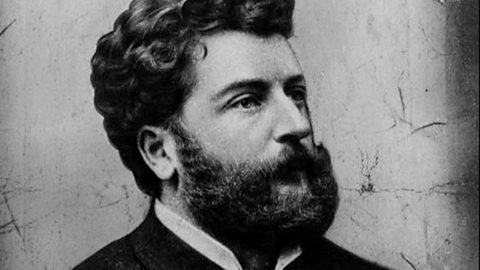Bobby Lockwood and Naomi Wilkinson introduce Bizet's 'Carmen'.
Bizet came from a very musical family – his father was a composer and his mother was a pianist – and his own musical talents were obvious from an early age. In fact, he was such a talented child that he was allowed to study at the Paris Conservatoire (music college) when he was just nine years old! Bizet's work remained individual throughout his career - he went on to write operas, symphonies and other orchestral pieces.
Bizet finished his most famous and most popular piece of work, the opera 'Carmen', in 1874. The 'Habanera' from Act I and the 'Toreador Song' from Act II of 'Carmen' are now two of the best known of all operatic arias. That's a pretty big achievement for an opera that Bizet originally predicted would be "a definite and hopeless flop". As it turned out, he couldn't have been more wrong. The bold drama of the storyline and punchiness of Bizet's melodies have made it a lasting favourite with audiences. Its powerful story of love, betrayal and revenge continues to capture imaginations the world over, almost 150 years on.
Listen out for: Its Spanish-sounding tunes. This is particularly impressive when you remember that Bizet was French!
Listen to how the music begins mysteriously, softly and beguilingly. The melody is played quietly until suddenly, out of the blue, the whole orchestra contrast the soft dynamic with two loud punctuations. Can you hear how these loud fortissimo phrases punctate the music in stark contrast to the rest of the extract?
Watch the 91»»±¨ Philharmonic Orchestra perform 'Habanera' from 'Carmen Suite No. 2'.
Georges Bizet
Bizet was a French composer and pianist who, after studying at the Paris Conservatoire, found it difficult to be taken seriously as an opera composer. His early works were mostly ignored and he made money by arranging music for other, lesser composers. In 1875, obsessed by all things Spanish, he wrote 'Carmen', a light opera with a serious ending about a beautiful girl who works in a factory.
The 91»»±¨ Philharmonic Orchestra perform 'Toreador Song' from 'Carmen Suite No. 2', conducted by Alpesh Chauhan.
Initially the piece was a flop - critics complained that it didn't have enough melody in it and Bizet died three months later thinking himself a failure. He didn't live to see 'Carmen' gradually grow into a worldwide phenomenon. It is now one of the most popular of all operas and exists in many versions. It is littered with famous, hummable tunes.

MP3s: Listen to the music or download the audio
Download the
Download the
To save to your computer: PC - right-click and save, Mac - ctrl-click and save.

Lesson Plans
Download classroom lesson plans to explore Bizet's music.
To save to your computer: PC - right-click and save, Mac - ctrl-click and save.
To enable all images to work in the Powerpoint files please save the file to your computer. To save to your computer: PC - right-click and save, Mac - ctrl-click and save.
Primary lesson plans:
Lesson plan by Rachel Leach
Suitable for:
*Key Stage 2 in England and Wales
*Second Level, P5-P7 in Scotland
*Key Stage 1/Key Stage 2 in Northern Ireland
Secondary lesson plans:
Lesson plan by Ann Barkway
Suitable for:
Key Stage 3 in England, Wales and Northern Ireland
Third and Fourth Level, S1-S3 in Scotland
'Habanera' arrangements: Play with simplified parts
All parts have been designed to work together to enable mixed-ability groups to perform together
Beginner/pre-Grade 1
- | | | | |
- | | |
- | |
- | | |
- | | |
- |
Grade 1-3
- | | |
- | | |
- | |
- | | |
- | | |
- |
Grade 4-5
- | | | |
- | | |
- | | | |
- | | |
- | | | |
- |
Combined score
Original instrumentation
In case you're considering using original parts together with these arrangements, you may find the composer's original instrumentation helpful:
2.2.2.2 – 4.2.3.1 – tmp+4, - strings
'Toreador Song' arrangements: Play with simplified parts
All parts have been designed to work together to enable mixed-ability groups to perform together
Beginner/pre-Grade 1
- | | | | |
- | | |
- | |
- ‚ô≠ | | |
- |
- |
Grade 1-3
- | | |
- | | |
- | |
- | | |
- |
- |
Grade 4-5
- | | | |
- | | |
- | | | |
- | | |
- |
Toreador Song is also available in the original key of F minor for Gd 4/5 players:
- | | | |
- | | |
- | |
- | | |
- |
Combined score
(transposed key of G minor)
Original instrumentation
In case you're considering using original parts together with these arrangements, you may find the composer's original instrumentation helpful:
2.2.2.2 – 4.2.3.1 – tmp+3, - strings